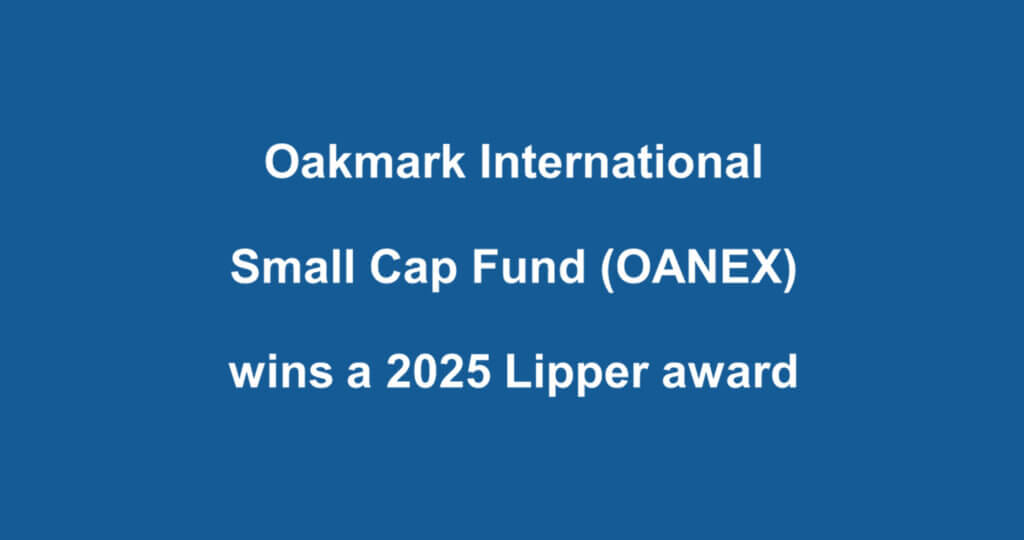Fellow Shareholders,
In the wake of the impact of the coronavirus pandemic, I am disappointed to write that the Oakmark International Fund and Oakmark International Small Cap Fund have had extremely weak performance numbers in the first calendar quarter of 2020. Please see individual Fund letters for performance data. Despite this extreme downdraft in share prices, our team remains convinced that our Funds continue to offer value for long-term investors.
The Shock vs. Fundamentals
The resulting shock to share prices from the uncertainty surrounding the above-mentioned pandemic has meant that many of the businesses in which we are invested have had share price declines in the 30-50% range. The role of our team is to determine what, in fact, given the best and most current information available, has happened to our measurement of intrinsic value.
It is our belief, based on simple economics and financial theory, that what makes a company valuable are the cash flow streams it is able to generate in the present and future. Whereas “Mr. Market” often merely considers the short term in pricing businesses, we believe this does not at all reflect the true intrinsic value of a business. And given how fluid this current crisis is, I would speculate that “Mr. Market” has become even more short term.
Even when we account for an extremely severe short-term global economic contraction followed by a muted recovery, our measurement of intrinsic value for most of our shareholdings drops by an amount that ranges from mid-single digit to low-double digit levels. Given this wide spread between how the market has priced these businesses and what we believe to be their intrinsic value as determined by cash flow streams, we believe today’s situation can be a great opportunity for value investors.
Our Actions
Since the beginning of this volatile market situation, we have been busy focusing on three things: remaining up to date on business values, keeping the portfolio “forward” positioned and seeking new investment opportunities.
Taking the first point, as we generally base position size in portfolios on the spread between market price and our measurement of value, it is critical that we stay current as to what we believe our businesses are valued. To this end, we have spent considerable time speaking to managements and other industry sources in keeping our estimates current. The fact that we have been working from home since mid-March has not been a deterrent. And it’s important to note that in almost all cases, our companies’ managements have proactively made themselves available to communicate with their shareholders.
Regarding the second point, with the extreme volatility in the market prices of businesses, our more moderate changes in our measurement of value have catalyzed increased portfolio trading and positioning. This is generally the case in volatile markets, but given the extreme price movements, even intraday, we have been quite busy keeping the portfolio position sizes consistent with potential upsides.
Lastly, given aggressive price movement everywhere, new idea research activities have picked up measurably, which provide new investment opportunities.
Value Investing – Revisited
This downturn has not only severely impacted our portfolios, but has caused the gap between “value stocks” and “non-value stocks” to expand significantly. We remain confident and steadfast that this divergence can create better future performance (please see our piece “The Value of Value”). Today, our portfolios trade at near all-time discounts to their historical averages, trading at around 40 cents on the dollar. For example, blue chip holdings, like BNP Paribas and Credit Suisse Group, trade for at or around 40% of tangible book value, which is below the valuation level during the last financial crisis, despite materially stronger balance sheets, in our opinion. Another example is BMW, the global leader in premium autos, which has an enterprise value under €20 billion, despite having excess cash on its balance sheet and what we estimate normalized sales, less their finance business of close to €100 billion, with operating profits of more than €7 billion by 2022.
This unique and unprecedented environment certainly isn’t pleasant, but we believe it has the potential to provide us with an opportunity for long-term value creation. Your patience and support are greatly appreciated during this extraordinary time.
The securities mentioned above comprise the following preliminary percentages of the Oakmark International Fund’s total net assets as of 03/31/20: BMW 3.7%, BNP Paribas 3.4% and Credit Suisse 3.4%.
View the full list of Oakmark International Fund holdings as of the most recent quarter-end.
The securities mentioned above comprise the following preliminary percentages of the Oakmark International Small Cap Fund’s total net assets as of 03/31/20: BMW 0%, BNP Paribas 0% and Credit Suisse 0%.
Portfolio holdings are subject to change without notice and are not intended as recommendations of individual stocks.
The funds’ portfolios tend to be invested in a relatively small number of stocks. As a result, the appreciation or depreciation of any one security held by the Fund will have a greater impact on the Funds’ net asset value than it would if the Fund invested in a larger number of securities. Although that strategy has the potential to generate attractive returns over time, it also increases the Funds’ volatility.
The stocks of smaller companies often involve more risk than the stocks of larger companies. Stocks of small companies tend to be more volatile and have a smaller public market than stocks of larger companies. Small companies may have a shorter history of operations than larger companies, may not have as great an ability to raise additional capital and may have a less diversified product line, making them more susceptible to market pressure.
Investing in foreign securities presents risks that in some ways may be greater than U.S. investments. Those risks include: currency fluctuation; different regulation, accounting standards, trading practices and levels of available information; generally higher transaction costs; and political risks.
The information, data, analyses, and opinions presented herein (including current investment themes, the portfolio managers’ research and investment process, and portfolio characteristics) are for informational purposes only and represent the investments and views of the portfolio managers and Harris Associates L.P. as of the date written and are subject to change and may change based on market and other conditions and without notice. This content is not a recommendation of or an offer to buy or sell a security and is not warranted to be correct, complete or accurate.
Certain comments herein are based on current expectations and are considered “forward-looking statements”. These forward looking statements reflect assumptions and analyses made by the portfolio managers and Harris Associates L.P. based on their experience and perception of historical trends, current conditions, expected future developments, and other factors they believe are relevant. Actual future results are subject to a number of investment and other risks and may prove to be different from expectations. Readers are cautioned not to place undue reliance on the forward-looking statements.
All information provided is as of 03/31/2020 unless otherwise specified.







